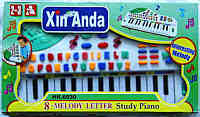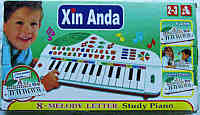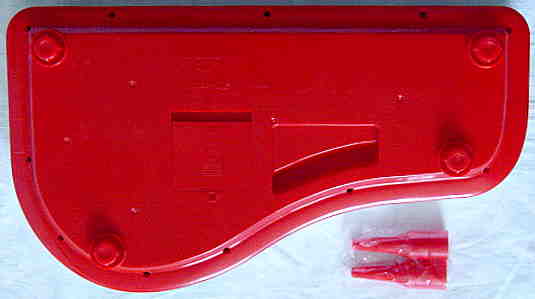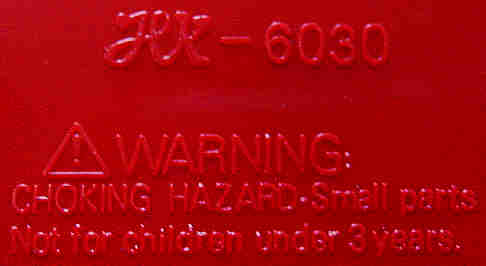| Xin
Anda - 8-Melody Letter Study Piano |
|
weird toy tablehooter with animal sound
& alphabet letter samples |
The creator of this Chinese toy tablehooter must have been dement or
drunk, because the keyboard octave starts with 'B' instead of 'C', and
despite the CPU supports 10 sharps, all black keys are fake and play the
same note like the white key left next to it, and 8 of the sharp notes
are even located on rectangular buttons instead. The control panel also
has no writing at all - possibly the case and PCB designer did not even
know the exact functions of the CPU.
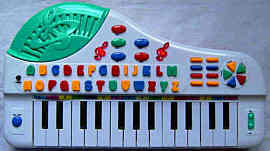
The thing from 2002 (PCB date label) has no volume control and yells
ear- tormenting loud with some grungy analogue transistor distortion. The
monophonic main voice can be switched between a plain squarewave music
box timbre and 5 low resolution animal voice samples. Most unusual are
the 26 alphabet letter buttons, those each say their letter name in English
and there is even a primitive audiogame that says a letter name and the
player has to press the corresponding letter button; correct presses play
an applause, wrong ones a spring noise. During the game there is a monophonic
squarewave monoto (melody loop) and every few correct letters it plays
the same polyphonic squarewave jingle, which nicely reminds to historical
videogames. But the low resolution sample voice mumbles so dull that it
is barely to understand, and the 'Z' is even pronounced "zee" instead of
"zet", which makes of it the perfect toy to annoy parents and confuse toddlers
until they have completely unlearned all correct piano playing skills and
letter names. There are also some nice polyphonic squarewave demos with
optional animal voices.
The OBS alphabet letter buttons may be interesting for tekkno to spell
words and form English sentences ("I-M-A-DJ", "Y-R-U-A-DJ" etc.) and they
also permit to rapidly retrigger their sample. I also like the mode intro
jingles with polyphonic squarewave and grainy sample sound, those have
this wonderful grungy old videogame style.
main features:
-
16 white mini keys (11 sharps are fake, octave begins wrongly)
-
8 buttons play sharp notes in a messy order
-
built-in small speaker
-
monophonic main voice
-
5 OBS animal voice preset sounds {bird, duck, frog, cat, dog} + squarewave
musicbox preset sound
-
26 OBS alphabet letter buttons (saying their letter in English)
-
alphabet learning audiogame
-
sound generator based on low resolution samples and a plain squarewave
musicbox timbre with zipper noise envelope and some DAC frequency aliasing
noise.
-
CPU="HK-5030A" (16 pin COB module with clock resistor)
-
8 demo melodies (2 note polyphonic squarewave with optional animal voice)
-
no volume control
-
no jacks
eastereggs:
-
2 additional sharp (black) keys addable (10 in total).
-
dedicated "one key play" mode button for demos addable.
modifications:
-
volume control added.
-
missing control panel writing added.
notes:
The squarewave musicbox timbre (called "piano" in manual) ignores key press
duration. Due to a strange multiplexed keyboard matrix scheme, sometimes
weak key or button presses trigger wrong functions. While the octave wrongly
begins on the 'B' key (an ratio to the sharps), the number strip above
the keys correctly starts there with '1'. (With Jin
Xin JX-20165 it is vice versa.)
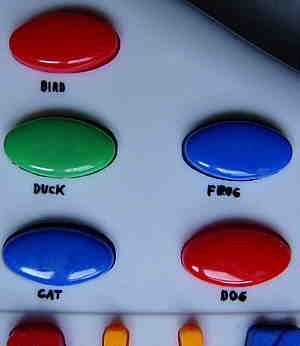 |
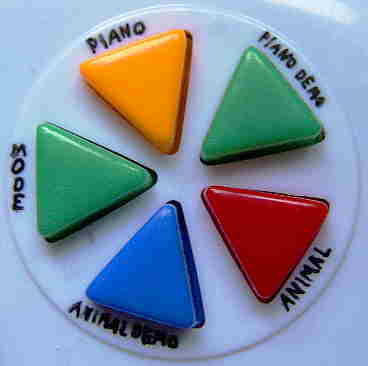 |
The buttons have no names thus here is what they do. The circle of triangular
buttons select the main modes. Counting clockwise from the upper left button
they are {piano, piano demos, animal sounds, animal demos, modes}. Each
button plays a polyphonic jingle before it takes effect. In "animal sounds"
mode you can select the 5 preset sounds with the oval OBS preset sound
buttons, those each play their sound when pressed. In "piano" (squarewave
musicbox) mode these buttons only play their sound but don't change the
main voice. In "piano demos" mode each key selects a demo song in 2 note
polyphonic squarewave musicbox sound. In "animal demos" mode these demos
additionally have a sample voice that cycles through the 5 animal preset
sounds (sound is selected by the note pitch of one of the squarewave channels?).
The "mode" button simply cycles through the functions of the 4 other triangular
buttons and a 5th function that plays the demos in monophonic musicbox
sound and then switches into "one key play" mode. The blue button left
next to the keys starts the alphabet learning mode.
circuit bending details
The CPU employs a resistor controlled clock oscillator that can be used
to add a pitch control. The power amplifier is made from 2 transistors
(the 2nd is below the PCB).
The count of the 26 letter + 5 animal samples + 1 squarewave sound sum
to exactly 32, which is a power of 2 and might be a technical addressing
limit within the quirky CPU. (But additionally there are also "applause",
"sproing" and a tooting bass sample, thus in total there are 35 sounds.)
keyboard matrix
This instrument has the messiest keyboard matrix I ever saw. At the CPU
it has 8 inputs and 4 individual output lines, but 3 additional output
rows connect simultaneously to one output through a diode and another through
a resistor (connecting both output directly for a test selects the same
functions). Another output row connects simply to +Vs. While this still
makes sense to save IC pins, it makes no sense at all anymore that the
order of the notes and alphabet letters ascends and descends alternatingly
in different rows, and the places for the 10 sharp (black) keys use different
rows than the naturals and the sharps are in almost random order. (In normal
keyboards all notes of black and white keys are in a monotonous order from
the lowest to the highest note.) Possibly this was designed to avoid wire
bridges on a single layer PCB.
adding sharp keys:
The CPU has the 4 keyboard matrix outputs O1..O4 at pin 1..4 and the
inputs I1..I8 at pin 5..12. The 8 sharps are on the 8 rectangular buttons
those output line is connected with a diode coming from O4 and a resistor
to O1. 2 additional sharps can be connected at I1 and I2 against +Vs (pin
14) through a low resistor. Theoretically the keyboard PCB could be likely
upgraded with sharps, but it would be a lot of work to cut and almost all
traces to the keys and re-wire them with coil wire. Also the keyboard could
be certainly aligned correctly by transplanting the keys 25 and 26 to the
left end of the keyboard.
one key play:
A one key play button can be connected at I4 through a low resistor
against +Vs. (This feature can be also accessed through the "mode" button
at the left side of the circle.)
volume control
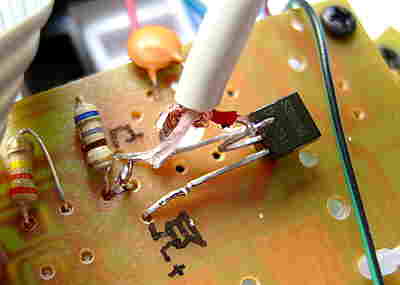 To
add a volume control pot, cut the (center) base pin of the transistor on
the top side of the PCB. Connect a potentiometer (mine is 5 kOhm) with
its right end to the now open CPU sound output (where the base pin was
connected). Connect the wiper with the transistor's base and the left end
with GND. To
add a volume control pot, cut the (center) base pin of the transistor on
the top side of the PCB. Connect a potentiometer (mine is 5 kOhm) with
its right end to the now open CPU sound output (where the base pin was
connected). Connect the wiper with the transistor's base and the left end
with GND. |
|
The 8 monophonic demo melodies are selected in "piano demos" or "animal
demos" mode through white keyboard keys and/ or the rectangular "sharp"
buttons.
-
Old McDonald Had a Farm
-
Mary Had a Little Lamb
-
Oh Susanna!
-
Jingle Bells
-
Twinkle Twinkle Little Star
-
This Old Man
-
Row, Row, Row the Boat
-
London Bridge Is Falling Down
Toy keyboards with very similar case shape but 37 midsize keys and no alphabet
buttons were released by Yongmei as YM-9903A (red, with key
lighting?) and YM-9902B (light blue); both seem to contain My
Song Maker hardware variants.
| removal
of these screws voids warranty... |
|
|
 |

|
|
| |
back
|
|
